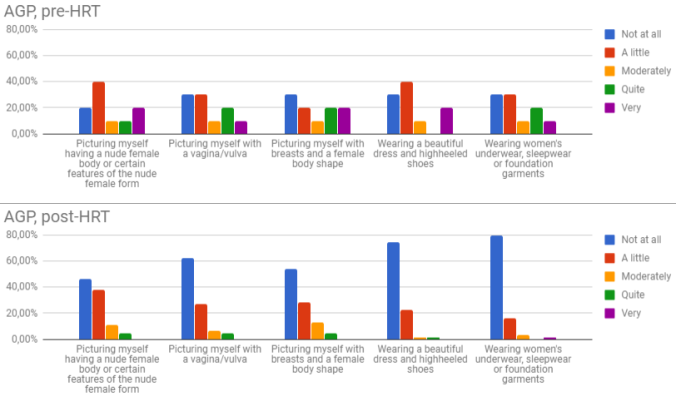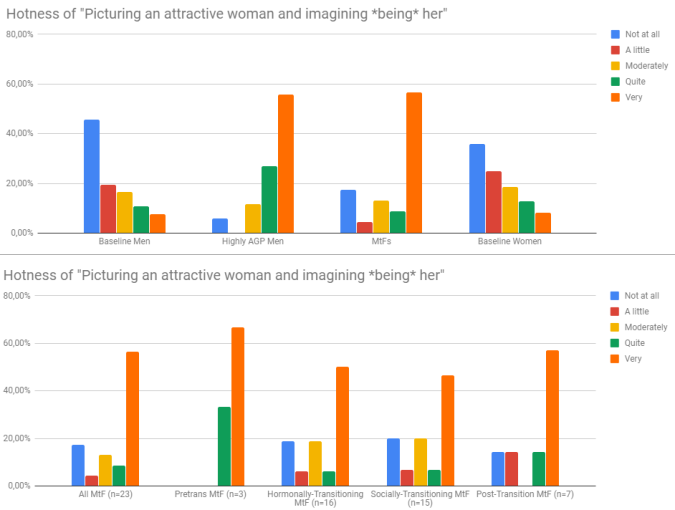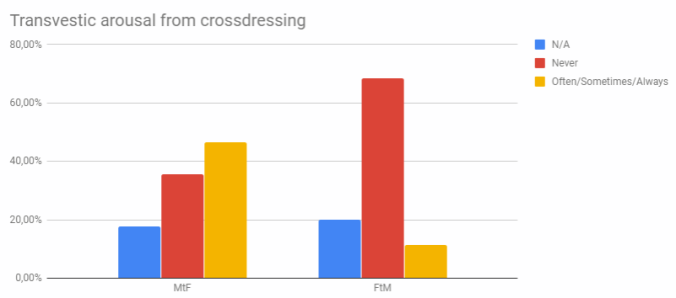It is commonly anecdotally reported that AGP goes away with gender transition for trans women. For example, many in this survey about AGP on /r/AskTransgender reported having experienced it going away, studies like Doorn (1994) found similar changes, and even surveys by me show that pretransition trans women have more AGP than posttransition ones:

Comparison of AGP rates in trans women who are pre-HRT vs post-HRT from a survey on 4chan. (Yes, 4chan is unreliable, but not uniquely so in a way that I would expect to mess with these results – after all, it’s similar to what we see from the other sources I’ve mentioned.)
So, with all of this evidence, how could I possibly deny that AGP disappears with transition? Well, let’s state what we’ve found above more clearly: if you take trans women, who know they’re being examined specifically in the context of trans issues, and ask them specifically about autogynephilia in the sense of something experienced by trans women, and in particular in an environment that expects it to disappear with transition, you’ll find that it disappears with transition. Yup, I’m going to call social desirability bias.
Probably the simplest solution to this is just to ask more stealthily. Don’t specifically ask trans women, ask people in general and consider the subset that happens to be trans. Don’t ask whether it disappeared with transition, just check if it did. Don’t make the purpose anything trans, just test it independently. And probably use a measure that gives different instead of the same results for cis women and trans women, just to make it harder to question the results. Here’s the results:

From my first survey asking people to look at and rate the attractiveness of various sorts of pornography, titled “Can you look at some porn For Science?”. Trans women remain very AGP regardless of transition status.
Obviously, this isn’t perfect; I’m sure there’s a ton of rough edges that could be cleaned up. Bigger sample size, asking about more forms of transition, checking social desirability bias, tweaking the question used, examining the effect that HRT has on libido, etc.. However, I’ve found similar results in other surveys that varied things a bit, so I expect it to generalize well.
So, let’s break down what I did a bit. First, I assessed AGP in trans women as part of a number of other paraphilic interests, asking “How sexually arousing would you find the following?”. I picked the phrasing “Picturing an attractive woman and imagining being her” because an AGP trans man suggested (based on his pre-transition sexuality) that this might work for assessing AGP in cis women (which is important because of the point that it would be stupid to use a scale that gave the same results in cis women and trans women). I also had an item asking about “Picturing myself as the opposite sex, or with certain physical features of the opposite sex”, which is what I used to define Highly AGP Men (who had to answer “Very” on that question to be considered “highly AGP”).
Now as you can see, having transitioned did not prevent trans women from being AGP. I asked about hormonal and social transition separately. Then I defined people to be pretransition if they had not started either but intended to either almost immediately or in the longer term, hormonally-transitioning if they were currently using HRT (regardless of progress), socially transitioning if they had to some degree socially transitioned (defined by the participants). Post transition was defined by having both hormonally transitioned (to the point of not expecting more changes from HRT) and socially transitioned (to the point where they did not intend to socially transition “more”). Even those entirely post-transition were usually very AGP!
This doesn’t even account for the fact that some people probably still saw through it or were in denial, or that some people’s libido might’ve been tanked to the point where their AGP is unobservable. It doesn’t account for the fact that some of the participants might’ve been HSTS (and at least some of the responses are compatible with being HSTS, but who knows when it comes to reddit…).
So that is my take: AGP does not go away with transition, but if you ask it in a context where the trans women want to present it as going away, they probably will.
